Energy-saving lamps: varieties, features, pros and cons
Table of contents
- 1 dark times
-
2 All in white and riding a white horse
- 2.1 define
-
3 Features of light sources
- 3.1 Luminescent
- 3.2 CFL
- 3.3 LED
- 4 Common properties
- 5 How to choose
- 6 conclusion
Greetings, comrades! Today I'm going to tell you what the current energy-saving lamps offer the Russian market, how they work and how different from each other. You and I will get to know the key features of different types of light bulbs and find out which ones are best used for home lighting.
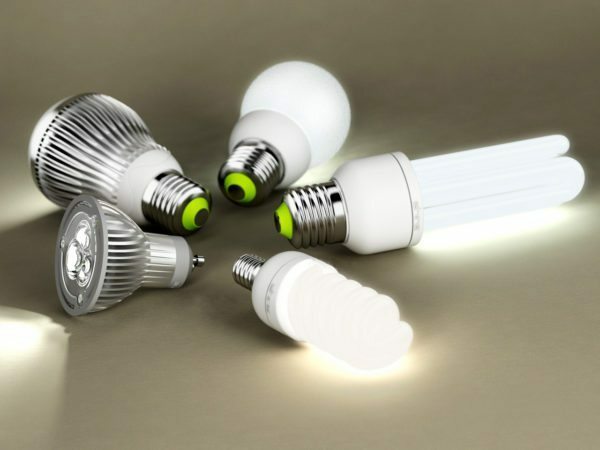
Two varieties of efficient bulbs - LED and compact fluorescent.
dark times
At first, a few words about the reasons for the sudden increase in demand for energy-saving bulbs. In 2010, the government officially announced the change of course in the field of energy optimization.
Since 2011, a ban on the production of lamps with a power consumption of 100 watts or higher. Two years later, it was planned to decommission 75-watt bulb, and a couple of years - all incandescent light bulbs as a class.
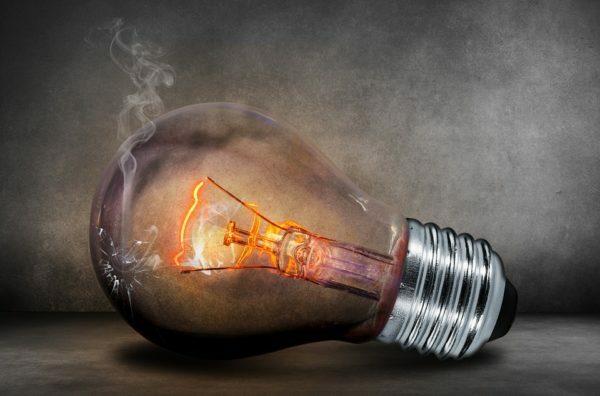
The plans for 2015 was listed decommissioning of all incandescent lamps.
As a positive example cited the experience of Europe: in it by 2010 per hundred inhabitants of no less than 40 energy-saving bulbs. In China - and is more than 80 lamps 100 inhabitants of the country. We - 2-3.
To replace the light source was put reduction of domestic energy consumption and discharge grids. The aim, without doubt, the good, if not one "but."
In 2011 the Russian Federation exported 22.7 billion kilowatt-hours of electricity. Imports in the same year amounted to 3.4 billion. With explicit excess generation capacity is not possible to give the inner consumer buying electricity and spend it in any way at his discretion at least strange.
Fortunately, to frank insanity did not happen: incandescent lamp up to 95 watts (to be honest, it is simply relabeled "weave") were available for sale.
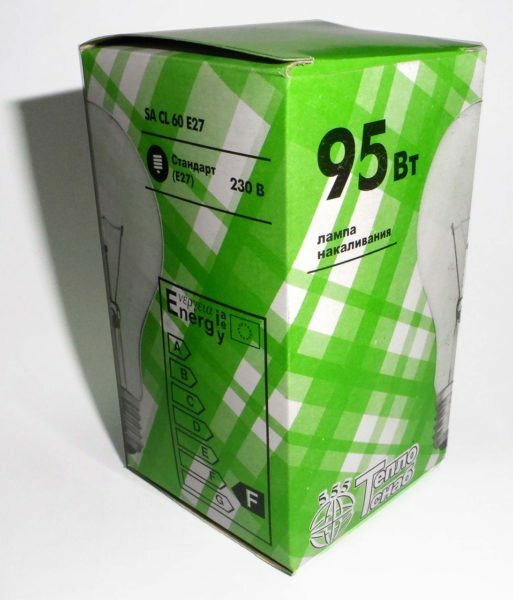
Incandescent lamp of 95 watts. Several years was previously known as the 100-watt.
However:
- The luminous flux of this lamp does not exceed 1100-1200 lumens, Which in accordance with current health standards (150 lm / m2) is sufficient to illuminate the entire living room area 6-8 squares;
- Modern lamps do not like the heat. They use plastics, plexiglass and vinyl insulation, poorly carrying high temperatures. Therefore, the maximum power consumption of a lamp is limited 60th watts.

The lamp is made entirely of plastic. Maximum power of the lamp - 60W.
All in white and riding a white horse
Energy-saving lamps solve both problems:
- At modest electrical power they provide to the luminosity of 3,000 lumens, which is sufficient for the 20-meter room;
- In this heat does not exceed 35-30 watts. Plastic lenses and wires in the lamp housing are safe: they do not threaten to overheat.
define
Energy saving lamp - a light source providing at least the same light output as incandescent lamps, with less power consumption. In the view of the majority of readers light-keeper - it's quite a specific light source, a compact fluorescent lamp.
In fact, fall into this category are two more of the light source:
| Picture | species |
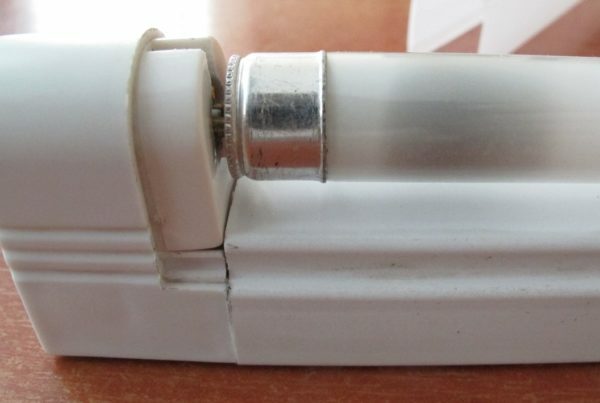 |
fluorescent, or fluorescent light. They are used in large quantities for several decades. Compact fluorescent light bulbs are different from them only in the form factor: a flask with a luminous glow electric discharge spiral curled ionized gas, and an electronic ballast (power converter providing ignition discharge) is placed in basement. |
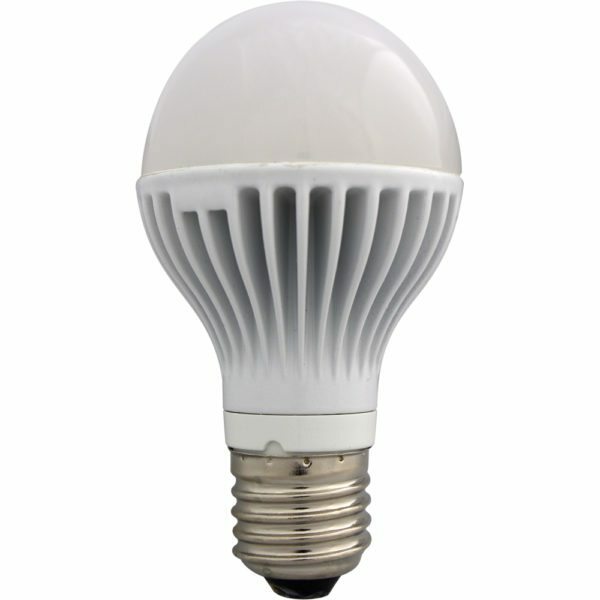 |
LED. Light Source - LEDs soldered to a flat or cylindrical platform, alternatively - forming a glowing filament (so-called «filament» lamps). For their energy corresponds compact pulse power unit, located in the basement or in a lamp housing. |
Switching power supply differs from transformer converting alternating current to direct high frequency pulses. This feature allows you to get the maximum power the PSU in its minimum size.
Halogen lamps are not energy efficient. They are valued primarily for its brightness and spectrum that most closely matches the spectrum of daily sunlight. Both qualities are achieved through high helix temperatures. halogen pair prevent evaporation of tungsten of which the one is made under strong heating.
Features of light sources
Luminescent
Form Factor: From household fixtures - a cylinder with contact pins at both ends. circular lamps, for the needs of advertising produced for hanging lamps - light sources in the form of letters, numbers, etc.
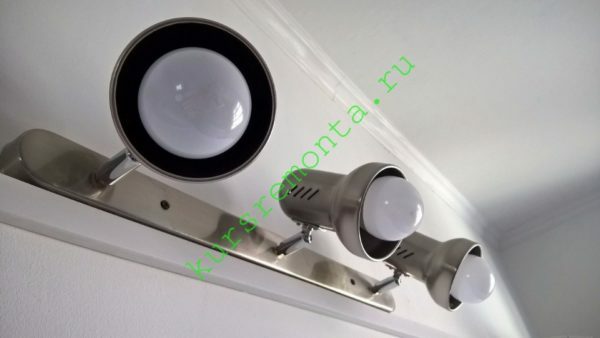
Household fluorescent lamp above the work surface in my kitchen.
Operating principle: Lamp bulb is filled with mercury vapor. Electric discharge it causes the ionized gas to emit in the ultraviolet spectrum. UV-radiation is converted into visible light by the phosphor coating the flask.
luminous efficiency: Up to 70 lumens per watt.
Life timeUp to 20 thousand hours.
Note: a normal incandescent lamp typical life span of less than 1,000 hours.
pros:
- Diffused light, not giving the shadows with sharp edges. This is very useful if you work in a home studio with small details. In make-up artists and stylists fluorescent lamps is also a great success: the uniformity of illumination allows you to avoid errors when applying makeup;

Due to its size fluorescent lamps provide uniform illumination without shadows underlined.
- A variety of color temperatures. By varying the composition of the phosphor, the lamp can be obtained with a warm, cool or neutral color. Discos commonly used UV lamps, which give a purple hue illuminated their white clothes.
Minuses:
- Mercury vapors are toxic. If you accidentally broke a fluorescent lamp, it is necessary to cause the MOE. Yes, usually we ignore the security and it is in vain: the cases of poisoning mercury vapor - are not uncommon;
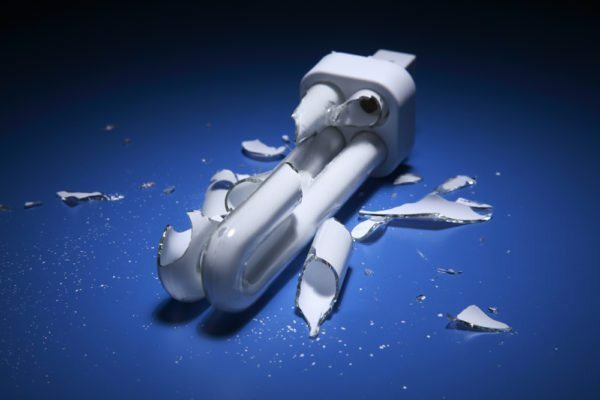
Mercury vapor from a broken CFL bulb remain in the room and does not benefit your health.
- Lamp bulb - glass and breaks when dropped from a small height;
- Phosphor give light with a narrow spectral bandwidth (i.e., 90% of the emitted color has a color temperature of 3000, 4000 or 6400K) that distorts the color reproduction;
- Phosphor degrades with time, and the luminosity of the lamp falls. Moreover, its power consumption is saved;
- Lampe needed ballast in the luminaire housing. Without it, a discharge lights.

Electronic control gear. It is placed in the lamp housing and serves as a much longer lamp.
CFL
Compact fluorescent lamp has all the key features of the usual - with a couple of corrections:
Form Factor: CFLs are compatible with most types of cartridges. The largest choice of models of lamps - in the form factor of E27 is compatible with the usual incandescent lamps. Well, it is quite logical: CFLs are designed primarily for their replacement in existing luminaires.
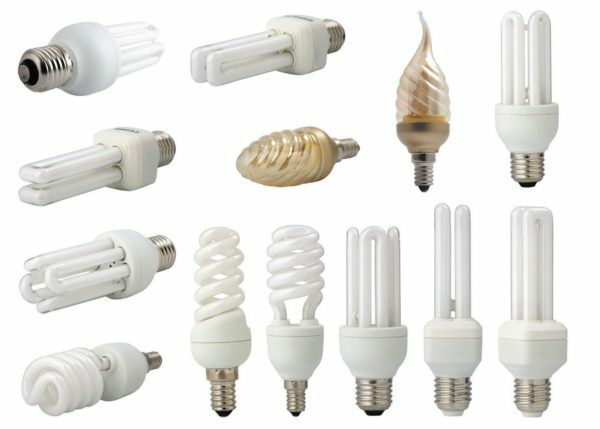
Compact fluorescent lamps under the popular form factors of caps.
luminous efficiency: Up to 50-60 lumens per watt. The drop of the luminous flux per unit power consumption relative to the full-size fluorescent lamp connected with compact power converter: loss grown on it - downside limiting miniaturization and simplification circuitry.
Attention, comrades: the majority of CFLs has limited compatibility with switches with LED backlight. When the power is turned off the lamp flashes every few seconds. The light is not too bright and can be seen only in the dark, but the resource and power converter phosphor thus consumed.
LED
LED lamps and CFLs appeared later to date (early 2017) close to having to displace them from the market. The main reason for such vigorous expansion - gradually falling price. Over the past two years, despite all the fluctuations of the national currency, it decreased approximately twice: directly with the luminosity of the lamp 1000 lumens costs about 100 rubles.
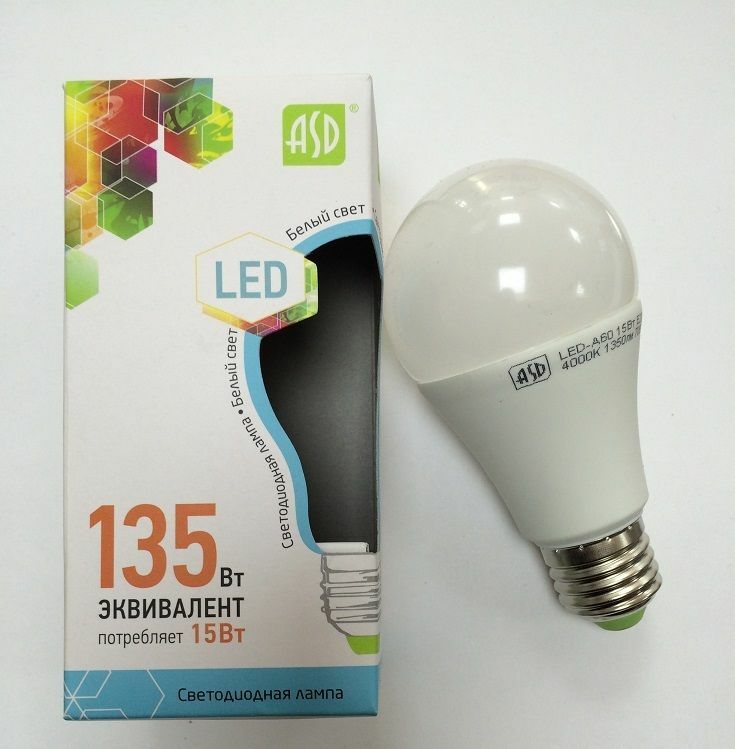
Lamp ASD LED-A60-standard: power of 15 W, the luminosity of 1350 lumens, the price of 140 rubles.
Let's see how to look like the LED lamp on the background of competing solutions.
Form Factor: Compatible with all existing cartridges.
Operating principle: Light source are LEDs soldered on a common circuit board and provided with a common pulse power supply. playground outside or cylinder with LEDs is normally closed diffuser - hood of opaque plastic.
luminous efficiency: Up to 110 lumens per watt.
Notice that restricts luminous efficiency switching power supply. Modern LEDs give up to 170 lm / W.
Life timeUp to 50 thousand hours.
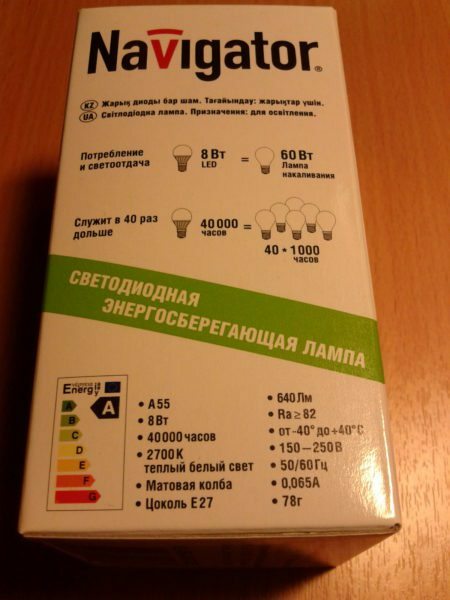
For this lamp producer claimed an impressive 40,000 hours of operation.
It is worth making a reservation.
Manufacturers often dissemble, wishful thinking. LEDs are actually able to serve the cherished 50 000 hours (a typical mode of operation of lighting in the apartment, this corresponds to 50 years of service).
However:
- Their lifespan is reduced at high temperature (Over 50-65 ° C). Meanwhile, high-power LED lamps can have a working temperature of up to 70-80 degrees. Especially if they are in the ceiling of an enclosed;

When closed, the ceiling of the lamp more heat and less is used.
- The inverter lamp power often costs the electrolytic capacitor. At high temperatures, it swells and loses its capacity after 2-3 years of operation. The lamp begins to shut down periodically during operation, and one day just does not light up.
The condenser is easy to rewire their own hands, hooked knife taped to the body of the plastic lens and lamp unscrewing board underneath. Extend the life of the new condenser will help the simple instruction: Use Low ESR electrolyte with an operating temperature of 105 ° C.

Installation electrolytic capacitor having an operating temperature of +105 ° C and a low equivalent series resistance (Low ESR) repeatedly increase power converter lamp life.
pros:
- Unattainable for fluorescent lamps efficiency;
- Long service life;
Number of on-off cycles do not affect the life of the LEDs. In this way they compare favorably to fluorescent lamps, for which the manufacturer guarantees no more than 2,000 inclusions.
- Absolute safety: the lamp does not contain harmful substances and can be disposed of along with other household waste;
- Accurate color reproduction. White light (4000 K) in spectral composition corresponds as closely as possible the daily sun;
Poor color sin extremely cheap lamp little-known manufacturers. They can distort the color shifting them toward the red end of the spectrum.
- In lamps with a flat plate beam of light - directional. This is very beneficial for ceiling and spot lamps.
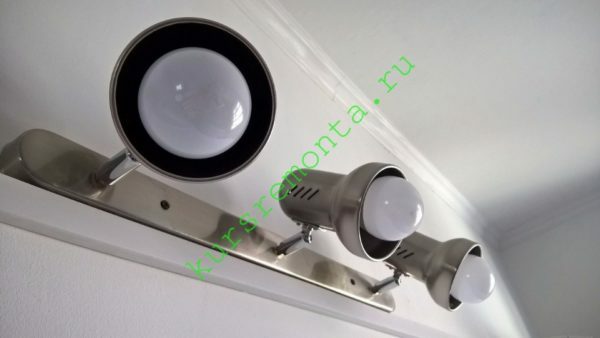
In the photo - the spot light with LED lamps illuminating the children's room in my house. All the light is directed in one direction, its dissipation is minimal.
Filament lamp with work light in all directions - in the same way as a conventional incandescent bulb.
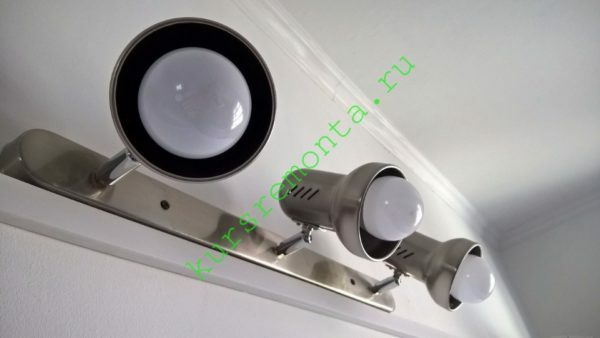
Luminaire with lamps in LED strands. And externally, and the spectrum of light, and the direction of these lamps are identical to incandescent lamps.
Minuses: Associated primarily with the race in prices between producers. In an effort to reduce the cost of production are affected:
- The heat sink. Instead of a full aluminum radiator heat is removed in the plastic housing. Result - work LEDs and the power supply at elevated temperatures and accelerated degradation;
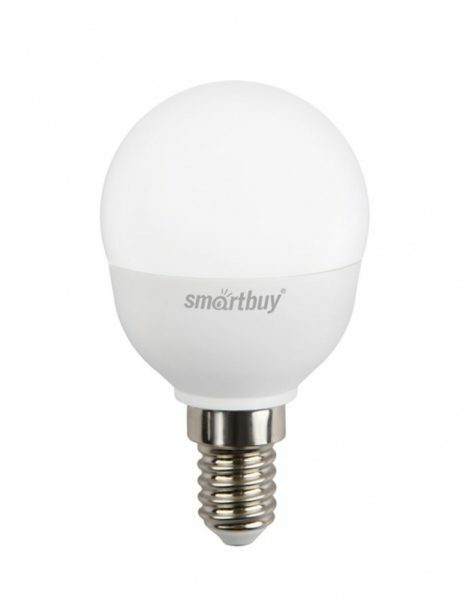
An unfortunate case of saving on cooling: for heat removal from the LED driver and responds smooth plastic housing.
- driver circuitry. Simplification of Constant power supply leads to a reduction in the operating voltage range. Most recently, I was faced with a good example: when the voltage drops below the net 190 volts issued two years ago, LED lamps continue to shine, and made six months ago, lamps in LED strands together extinguished.

Reason fastidiousness modern lamp in relation to feeding - in a very simplified driver. From full voltage regulator was only a rectifier that converts AC to DC.
Common properties
There are a couple of differences incandescent lamps and energy-saving lamps, the total for all the latest types.
- Saving lamps in the bulk is not dimmed. The reason is pretty obvious: they have their own power supply with a voltage regulator. As long as the voltage at the input of lamp driver is not out of range, it is shining at full capacity; as soon as the voltage drops below the PSU simply shut down;
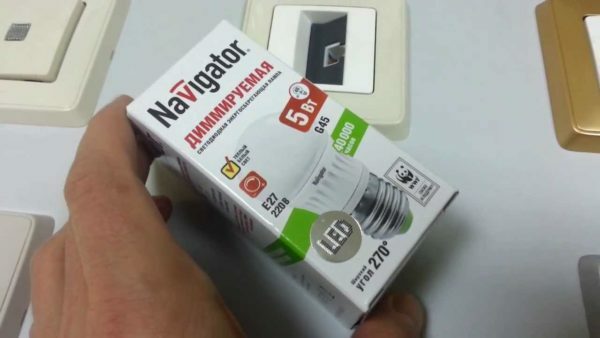
In the past few years, went on sale dimmable LED lamps. Tension on their light-emitting diodes are linearly dependent on the input voltage.
- And fluorescent and LED light sources are sensitive to high humidity. Dampness causes a hermetic closure in BP and lamp failure. Exception - protected luminaires IP 67 housings, impervious to water and dust.
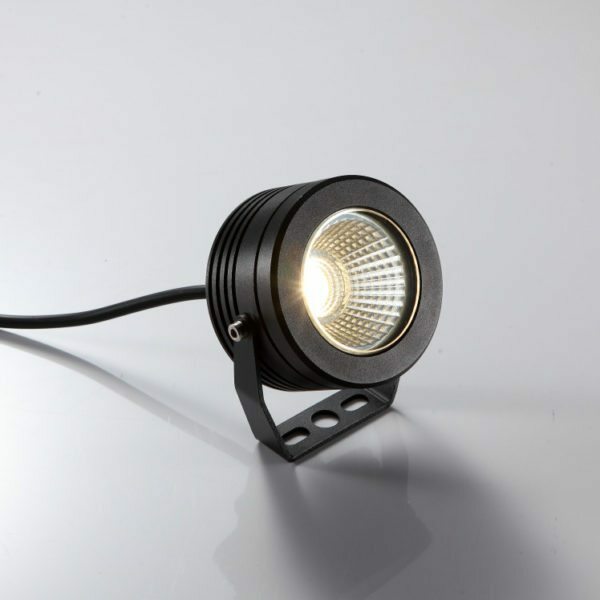
Protected LED lamp by IP67. It can work in a dusty or damp environment.
How to choose
On what grounds and how to choose energy-saving lamps for the home?
First and foremost: our choice - the LEDs. They came to the CFL cost and long gone far ahead in terms of efficiency, longevity and quality of lighting.
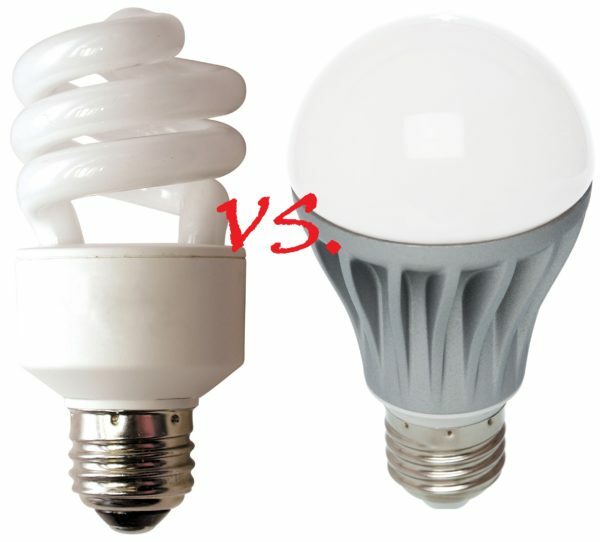
In 2017, the choice is quite straightforward. LED light sources have won with a crushing score.
Further.
On lamp packaging always given three options.
- Colour temperature. 2700-3000K corresponds to the spectrum incandescent lamps, 4000K - neutral daylight 6400K perceived as cold light. In my opinion, a warm light less eyestrain, but provides the perfect neutral color rendition. This is particularly important for the notorious make-up artists, stylists and photo and video shooting;
The color temperature of the light source and the perception of light.
- power consumption. From it depends on the luminosity of the lamp, but it is not linear: the luminosity is determined, in addition, efficiency and power supply (in case of LED lamps) generation used LEDs;
- Glow in the lumen. You need to pay attention to the ratio of the luminosity to power. It should be no worse than 50 lm / W for compact fluorescent and 90 lm / W for LED bulbs.
If you have the opportunity to turn on the lamp, spend a couple of tests:
| Picture | Description of the test |
 |
Color. White sheet of paper in the light of a lamp with a color temperature of 4000K should be just white, and not give red. For lamps let warm light yellow. |
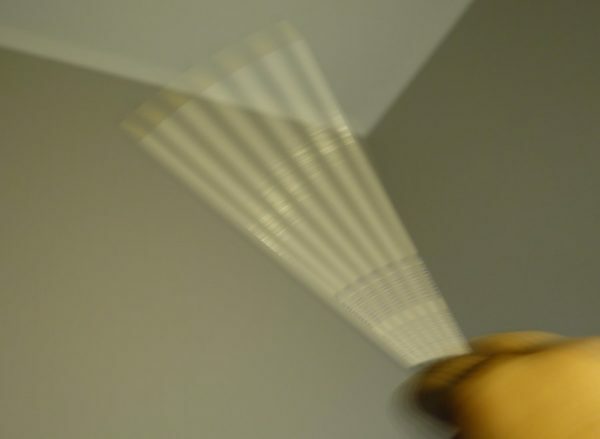 |
pencil test (When you look at the lamp and quickly waving before the eyes of a pencil) should not give the effect of "strobe". If you see such an effect, it is flickering LEDs with low frequency. From it significantly easier on the eyes, and this lamp is better not to take. |
conclusion
We assume our acquaintance with modern light sources held. Videos in this article will help you decide which is better for energy-saving bulbs at home in your particular case. As always, I appreciate your comments and additions. Good luck, comrades!
